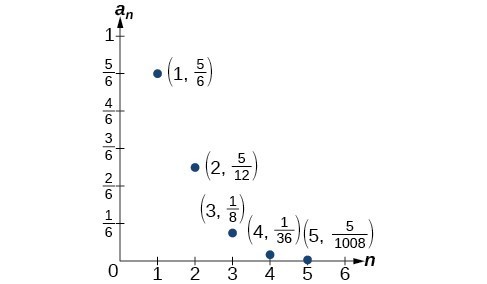Sequences Defined by a Recursive Formula
Learning Outcomes
- Write terms of a sequence defined by a recursive formula
- Write terms of a sequence using factorial notation
[latex]\begin{align}{a}_{1}&=3 \\ {a}_{n}&=2{a}_{n - 1}-1, \text{for } n\ge 2 \end{align}[/latex] We can find the subsequent terms of the sequence using the first term.
[latex]\begin{align}{a}_{1}&=3\\ {a}_{2}&=2{a}_{1}-1=2\left(3\right)-1=5\\ {a}_{3}&=2{a}_{2}-1=2\left(5\right)-1=9\\ {a}_{4}&=2{a}_{3}-1=2\left(9\right)-1=17\end{align}[/latex] So the first four terms of the sequence are [latex]\left\{3,5,9,17\right\}[/latex]. The recursive formula for the Fibonacci sequence states the first two terms and defines each successive term as the sum of the preceding two terms.
[latex]\begin{align}{a}_{1}&=1 \\ {a}_{2}&=1 \\ {a}_{n}&={a}_{n - 1}+{a}_{n - 2}, \text{for } n\ge 3 \end{align}[/latex] To find the tenth term of the sequence, for example, we would need to add the eighth and ninth terms. We saw above that the eighth and ninth terms are 21 and 34, so
[latex]{a}_{10}={a}_{9}+{a}_{8}=34+21=55[/latex]
A General Note: Recursive Formula
A recursive formula is a formula that defines each term of a sequence using preceding term(s). Recursive formulas must always state the initial term, or terms, of the sequence.Q & A
Must the first two terms always be given in a recursive formula?
No. The Fibonacci sequence defines each term using the two preceding terms, but many recursive formulas define each term using only one preceding term. These sequences need only the first term to be defined.How To: Given a recursive formula with only the first term provided, write the first [latex]n[/latex] terms of a sequence.
- Identify the initial term, [latex]{a}_{1}[/latex], which is given as part of the formula. This is the first term.
- To find the second term, [latex]{a}_{2}[/latex], substitute the initial term into the formula for [latex]{a}_{n - 1}[/latex]. Solve.
- To find the third term, [latex]{a}_{3}[/latex], substitute the second term into the formula. Solve.
- Repeat until you have solved for the [latex]n\text{th}[/latex] term.
Example: Writing the Terms of a Sequence Defined by a Recursive Formula
Write the first five terms of the sequence defined by the recursive formula.[latex]\begin{align} {a}_{1}&=9 \\ {a}_{n}&=3{a}_{n - 1}-20\text{, for }n\ge 2 \end{align}[/latex]
Answer: The first term is given in the formula. For each subsequent term, we replace [latex]{a}_{n - 1}[/latex] with the value of the preceding term.
[latex]\begin{align}&n=1 && {a}_{1}=9 \\ &n=2 && {a}_{2}=3{a}_{1}-20=3\left(9\right)-20=27 - 20=7 \\ &n=3 && {a}_{3}=3{a}_{2}-20=3\left(7\right)-20=21 - 20=1 \\ &n=4 && {a}_{4}=3{a}_{3}-20=3\left(1\right)-20=3 - 20=-17 \\ &n=5 && {a}_{5}=3{a}_{4}-20=3\left(-17\right)-20=-51 - 20=-71 \end{align}[/latex] The first five terms are [latex]\left\{9,7,1,-17,-71\right\}[/latex]
Try It
Write the first five terms of the sequence defined by the recursive formula.[latex]\begin{align}{a}_{1}&=2\\ {a}_{n}&=2{a}_{n - 1}+1\text{, for }n\ge 2\end{align}[/latex]
Answer: [latex-display]\left\{2, 5, 11, 23, 47\right\}[/latex-display]
[embed]Using Factorial Notation
a new operator: factorial
We saw a new operator introduced earlier while studying functions, the composition operator, [latex]\circ[/latex], which indicated we should compose two functions. Now we see another new operator, factorial, [latex]![/latex]. It doesn't mean we should get excited about its pronunciation, though! Factorial asks us to multiply together all the positive integers that come before the number in front of the symbol. See the examples below. Factorial is used heavily in Combinatorics, a branch of mathematics that is concerned with methods for counting sets.A GENERAL NOTE: FACTORIAL
n factorial is a mathematical operation that can be defined using a recursive formula. The factorial of [latex]n[/latex], denoted [latex]n![/latex], is defined for a positive integer [latex]n[/latex] as:Try It
[embed]Q & A
CAN FACTORIALS ALWAYS BE FOUND USING A CALCULATOR?
No. Factorials get large very quickly—faster than even exponential functions! When the output gets too large for the calculator, it will not be able to calculate the factorial.EXAMPLE: WRITING THE TERMS OF A SEQUENCE USING FACTORIALS
Write the first five terms of the sequence defined by the explicit formula [latex]{a}_{n}=\dfrac{5n}{\left(n+2\right)!}[/latex].Answer: Substitute [latex]n=1,n=2[/latex], and so on in the formula.

Try It
Write the first five terms of the sequence defined by the explicit formula [latex]{a}_{n}=\dfrac{\left(n+1\right)!}{2n}[/latex].Answer: The first five terms are [latex]\displaystyle \left\{1, \frac{3}{2}, 4,15,72\right\}[/latex]
[embed]Licenses & Attributions
CC licensed content, Original
- Revision and Adaptation. Provided by: Lumen Learning License: CC BY: Attribution.
CC licensed content, Shared previously
- College Algebra. Provided by: OpenStax Authored by: Abramson, Jay et al.. License: CC BY: Attribution. License terms: Download for free at http://cnx.org/contents/[email protected].
- Question ID 5812. Authored by: David Lippman. License: CC BY: Attribution. License terms: IMathAS Community LicenseCC-BY + GPL.
- Question ID 6107 . Authored by: Gregg Harbaugh. License: CC BY: Attribution. License terms: IMathAS Community License CC-BY + GPL.
- Question ID 19458. Authored by: James Sousa. License: CC BY: Attribution. License terms: IMathAS Community License CC-BY + GPL.
- Question ID 5846. Authored by: WebWork-Rochester. License: CC BY: Attribution. License terms: IMathAS Community License CC-BY + GPL.
- Question ID 68773. Authored by: Roy Shahbazian. License: CC BY: Attribution. License terms: IMathAS Community License CC-BY + GPL.
CC licensed content, Specific attribution
- Precalculus. Provided by: OpenStax Authored by: OpenStax College. Located at: https://cnx.org/contents/[email protected]:1/Preface. License: CC BY: Attribution.

